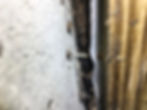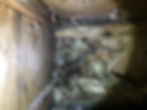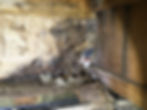Deck Ledger Board Flashing
- Michael Talotta
- Apr 9, 2018
- 2 min read
One of the biggest issues that I come across when inspecting decks and porches is the lack of or improperly installed ledger board flashing. The ledger board attaches to the house rim joist and is what holds the deck to the house. So basically, this board is carrying half of the weight of the deck or porch. The ledger board should be attached to the home with either lag bolts or structural screws and these fasteners are typically staggered as to not split the ledger board. The fasteners should also be compatible with pressure treated wood and be long enough to extend through the rim joist.
Nails should not be used as they are smooth and provide little grip on the board in which the ledger board is attaching to.
So lets get to the flashing...Prior to installing the ledger board, a moisture barrier should be installed behind the ledger board. The purpose of this barrier is to protect moisture from getting up against sheathing and rim joist. Many contractors will use aluminum, vinyl or an adhesive weather shield. It is important that the flashing extends up beneath the siding.
Quite often I come across homes that have absolutely no flashing behind the ledger board. Below is a picture from beneath a deck and you can see how even though house wrap is present between sheathing and ledger board, the sheathing has taken on water and is rotting. Also notice how the ledger board is fastened with nails.

This brings us to the next important piece of flashing. The flashing that is installed on top of the ledger board is Z Flashing. This metal flashing extends up beneath the siding and wraps over the top of the deck ledger board. Its purpose is to keep water from getting trapped between the ledger board and house. I have also seen contractors that have used tar paper as flashing but it is not ideal because it can be easily torn. The picture below is a deck with proper fasteners and visible ledger flashing.

The following pictures come from a small deck that had metal flashing behind the ledger board but no Z flashing was present. The metal flashing likely did not extend up far enough beneath the siding because water had gotten behind the ledger board and rotted through the sheathing. The other issue was that there was no rim joist present, only sheathing attached to the ends of the floor joists. This doesn't provide much holding area for the ledger board fasteners which explains the extra blocking that had been put in place beneath the ledger board for additional support.

These pictures are of the rot in the sill area of the basement. Look close at the rotted areas near the floor joists and you can see the backside of the metal flashing where the OSB sheathing had deteriorated.


I come across this type of damage a lot and this is a fine example of why it pays to hire a professional contractor to build your deck or porch. If you have ever heard a news story about a deck collapse, it is often associated with rot behind the ledger board or poor fasteners.





